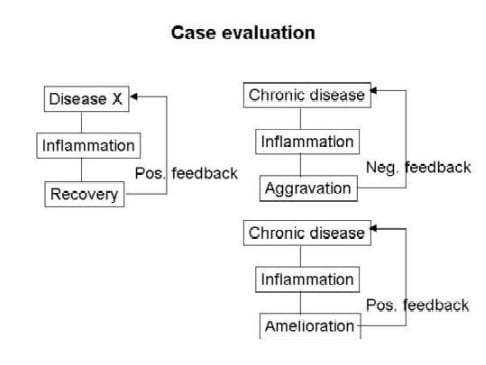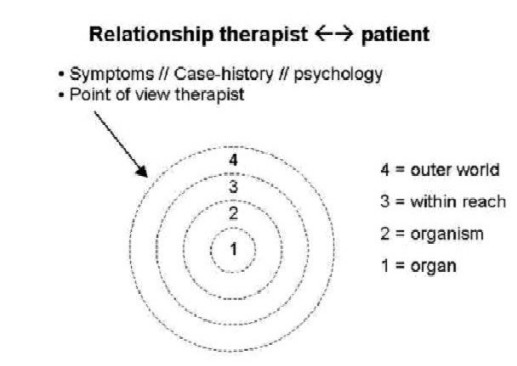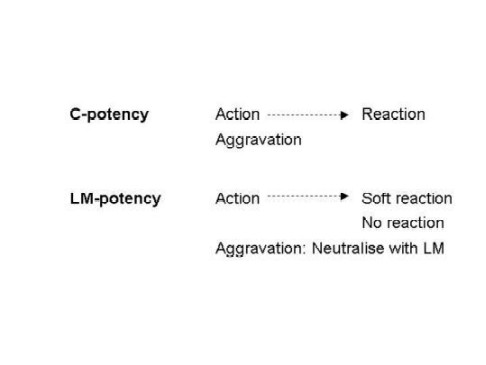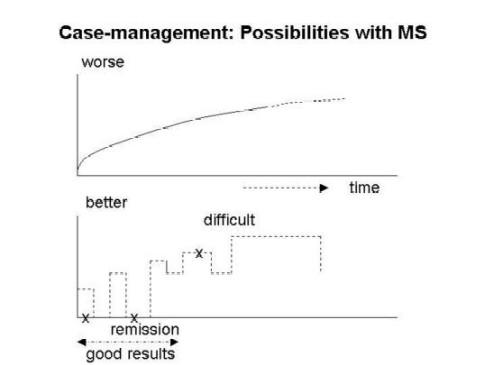Introduction
Treatment of patients with chronic diseases has been given considerable attention by the early homeopaths, Hahnemann, Kent and others.
Presently in allopathy we often find that chronic patients are considered to be “not-curable” and medical treatment is focused on maintaining the status quo, slowing the process of deterioration, or preventing pain.
This also accounts for quite a number of homeopaths, who most likely in their treatment, will aim at the same objectives as the allopaths, and are reluctant or scared to venture into a venue leading towards true healing. This is because of a lack of trust in their own capabilities, fear for social repercussions or just lack of knowledge on this subject.
Hahnemann discovered that he was able to cure with homeopathy, both acute and superficial complaints, but that when treating patients with chronic diseases, a temporary amelioration often was followed by a significant aggravation. This brought him to the miasma-concept, the deeper, genetically based disposition of each person. One of the main points I will stress is this lecture, is my conviction that having profound knowledge of miasma is essential when you treat patients with a chronic disease. So understanding the true nature of a patient’s miasma is one of the most important factors for your success as a therapist and the accuracy of the prognosis of the treatment.
In my practice I have encountered gradually more and more patients with a chronic disease, most of them MS-patients. While treating them, I rediscovered some of the basic truths of homeopathy. I developed some ideas about failure and success in treating chronic diseases, and why some persons can be cured more easily compared to others. I will share with you some of my experiences with MS-patients and highlight some points I personally learned from my cases; what kind of confrontations I had, where I was able to really help, what mistakes I made. Treating MS-patients taught me to really understand some parts of the Organon and taught me what homeopathy really is about.
It took some courage for me to start treating patients with chronic diseases. But as one acquires more knowledge and understanding of the basics of the illness, there are a lot of situations in which it is very worthwhile to start the treatment, both for the patient and the therapist. Roger Savage invited me specially to cover this topic, to provide an impulse, to enhance a culture in which treatment of patients with chronic diseases is normal practice among homeopaths.
In this short lecture I can only present one case as an example and I will confine myself to “keynotes” while covering a period of several years. I will present short fragments of videos of the case and I will comment on MS, case management and the use of LM-potencies versus C-potencies. I will conclude with some comments on miasmas and Hering’s Law.
Comments on the illness Multiple Sclerosis
-
Stuck
-
Tendency to inflamation
-
What / Where is affected ?
-
Neurological examination
-
Keynotes and Non-Keynotes for Multiple Sclerosis
-
Anamnesis and Case-Management
Comments on MS
“Stuck” = blocked, there are no modalities and no problems. Inflexibility.
The patient says everything is all right.
It is easier to have cases with strong modalities, those are more curable.
E.g. sensitive to weather changes, < before menses, < emotions.
A problem arises when there is a tendency towards inflammations in a patient. These persons are more difficult to treat, because after each inflammation the overall condition and the MS itself is worsened. I will comment on this later in more detail.
What is affected ? This is a very important question. For example, when the eyes are affected you can consider this a good sign. As the eyes are located near the brains, affected eyes constitutes an early stage in the illness. Ascending paralysis is a bad sign, the affection has already traveled far in the body.
Neurological examination. This is a very important part of the interview. Establishing the condition of the reflexes, looking for nystagmus, observing the gait of the patient, how long they can walk, on the toes or not, the balance of the body, how they walk with eyes closed. Also the level of tiredness is important to observe.
What are Keynotes / Non – Keynotes for Multiple Sclerosis ?
Non-keynotes ( not valuable in the repertory ) for Multiple Sclerosis are:
-
ascending and descending paralysis
-
tremor and jerkins
-
hyper reflex
-
burning heat (very common)
-
numbness
-
deafness
Keynotes are for example:
-
a wandering burning ( more peculiar )
-
burning which existed before the disease
-
when the eyes are paralyzed: which muscle is affected
-
one side is numb ( e.g. one side of the tongue )
-
when someone is better from heat instead of worse
-
when someone mentions a symptom repeatedly that for all other MS-patients seems to be so trivial ( e.g. complaining about the inability to walk)
Anamnesis
A very important issue is the fact that MS-patients often forget what happened to them in the past. The paralysis is not constrained to the motor nerves, memory is affected also. Therefore the personal observations of the therapist are even more important than with “normal” patients. E.g. face expression in contrast to verbal statements. Also the case history is of extreme importance. You need to know every illness of the past, not in the first place to find the simillimum, but especially to know how to react upon aggravations and/or re-appearance of old ailments.
So, case management is very important, anticipation on former diseases and a thorough explanation to the patient of the concepts of homeopathy. The patient has heard so often that MS is incurable and that every complication will signify a decline in their condition, that their self confidence is diminished, they lack confidence. Their environment is mostly ignorant of all ins and outs of homeopathic treatment of MS. Education of the patient and family will take some time: indicate things such as the necessity to take time to rest when they feel sick, the influence of heat on myelin etc.
Multiple Sclerosis
-
Degeneration of Myelin
-
Etiology
-
Importance of Temperature
-
Rapid Atmospheric Changes
-
Peculiars!!!
One of the most important expressions of MS is the degeneration of myelin. Myelin is the fatty-like substance covering all nerve cells. In MS-patients the myelin is very sensitive to heat; the degeneration process will increase due to increased body temperature. This is why inflammations constitute a major risk factor in MS-patients. I will elaborate a little more about MS and inflammation, later on.
Etiology – MS can be induced by more than one factor. It might be linked with geography (it is more widely spread between 40 and 60 degrees N-latitude, Scotland!), with genetic constitution, and with other external stress factors (viruses). The exact reason why someone acquires the disease in a particular case is still unclear, although it is said that 27% of the cases are related to infections.
Temperature – When the body temperature increases the condition of the nerves decreases. One should be aware of the possibility that in bad cases, the patient will not completely recover from too high temperatures.
A fair number of the MS-patients are sensitive to humidity and rapid atmospheric changes.
As stated before, one should pay special attention to the peculiars, because the modalities often are not of much help with MS-patients.
This sheet represents a summary of the case evaluation. In non MS cases recovery from an inflammation nearly always has a positive influence on the course of the illness and the overall health. In MS-cases you cannot be sure of that. The influence of body temperature on the myelin might have a negative feedback.
This sheet represents a summary of the case evaluation. In non MS cases recover from an inflammation nearly always has a positive influence on the course of the illness and the overall health. In MS-cases you cannot be sure of that. The influence of body temperature on the myelin might have a negative feedback.
Figure 1
One can consider Homeopathy as a delicate form of communication. So one of the basic rules for a homeopath is to tune in the awareness of the patient. The better you communicate, the more likely it is that you will find the right simillimum. No communication means no simillimum. In order to achieve a maximum of fine tuning, it is necessary for both patient and therapist to achieve positions as equal as possible. In an equal, non confronting situation people will become more aware of themselves, thus providing the best opportunity for the therapist to find the simillimum.
This is also the reason why I prefer LM-potencies with these patients. LM = 1 : 500 x 100.
LM1 is still rather material in its impact, LM2 and higher have a significant impact on the more spiritual level.
So, using higher LM-potencies will facilitate a swift shift in the patient to more immaterial levels.
The number 5 is supposed to have had special meaning to Hahnemann (see Stoteler), it also represents the 5 extreme points of the human body in a pentacle.
Working with C-potencies means working according to the action/reaction principle. LM potencies act with a soft reaction (no or little aggravation) or no reaction. Aggravations can be easily neutralized with a LM potency (§ 253 Organon). It is very important to watch the patient and prevent an aggravation, not only because of the reasons mentioned above in relation to temperature, but also because of the mental disposition of MS-patients where aggravation might block the awareness and the overall feeling of well-being and might result in further deterioration of the situation of the patient.
Generally speaking MS can develop according to two models.
The first model shows a continuous increase in the severity of the symptoms. These patients are very difficult to treat and due to the gradual decrease in the condition of the patient it might also be a discouraging experience.
In the second model I show those cases in which periods of increasing severity of the symptoms are altered by periods of remission. If a patient comes to visit you during such a period of remission, you may have very good results in your treatment. When a patient comes to you in a peak, in a rather bad shape, treatment will prove to be more difficult.
So, in order to make a good prognosis, it is very important to make a good judgment where on the curve the patient is located at the moment of treatment.










I am Internal Medicine specialist with special interest in Thyroid Diseases. I read and really liked this article and I’d like to interact with the author. Please give me her E mail ID if she agrees.
Sincerely,
Tarun Sekhri